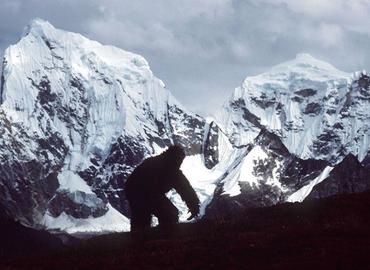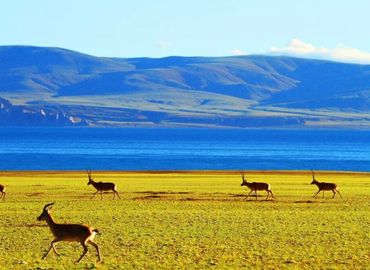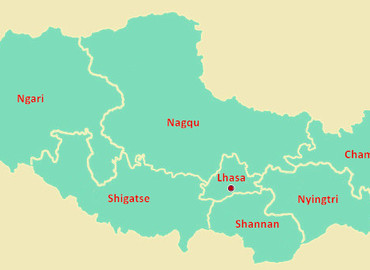Wild Animals in Tibet
- Catherine
- Last Updated : 02/26/2025
The imposing Tibetan Plateau is located in the central southern part of the Eurasian continent, with an average elevation of more than 4,000 meters. It is the highest plateau in the world and is known as the "Roof of the World". Located on this highest terrain in the world, Tibet has been endowed with a series of unique natural characteristics, due to high altitude, young history, and unique geographical location, and formed a distinctive plateau and mountainous natural landscape, including alpine shrubs, meadows, alpine grasslands, alpine deserts, and alpine cushion vegetation. Accordingly, in Tibet, unique vegetation and animal species have evolved, all of which have special plateau features.
Tibetan Animals
According to statistics, Tibet has 118 species of mammals, 473 species of birds, 49 species of reptiles, 44 species of amphibians, 61 species of fish, and more than 2,300 species of insects. Tibetan antelopes, wild yaks, kiang, and argali are rare animals of Tibet. They are all protected animals and have high ornamental value. The white-lipped deer is especially unique to China. It is one of the rare animals in the world and is listed as a national first-class protected animal. Walking on the Plateau, they are special scenery on the plateau.
Touring in Tibet, you can only see wild animals from a distance most of the time. What do the beautiful elves on the plateau look like? Let's take a look at the top animals in Tibet.
Tibetan Antelope
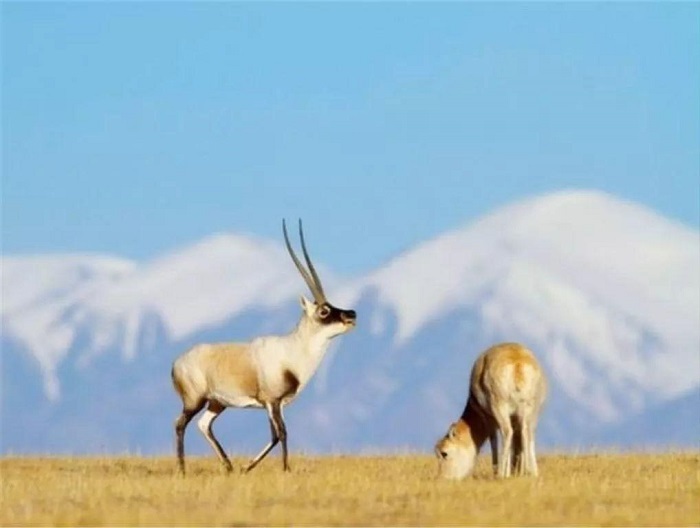
Tibetan antelope mainly inhabit alpine grasslands, meadows, and alpine deserts at an altitude of 3,700 to 5,500 meters. Tibetan antelopes are called "the pride of Hoh Xil". The back of the Tibetan antelope is reddish-brown, and the abdomen is light brown or off-white. Tibetan antelope can only be seen on the Tibetan Plateau, and it is also a rare species.
Tibetan antelopes live in groups, even forming large groups of tens of thousands, and their living habits are very complicated. Females are different from males. From May to July every year, thousands of female Tibetan antelopes will depart from the three national nature reserves of Qinghai Sanjiangyuan Nature Reserve, Tibet Qiangtang Nature Reserve, or Xinjiang Altun Mountain National Nature Reserve along a fixed route to lamb by the Zhuonai Lake in Hoh Xil. >>See more about Tibetan Antelope
Tibetan Gazelle
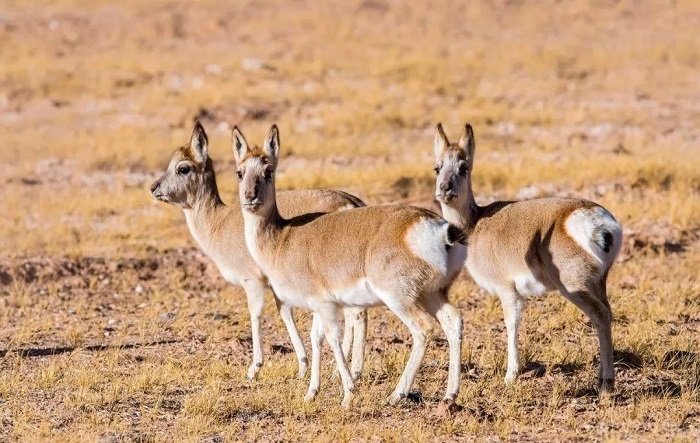
Tibetan gazelle is also called Tibetan yellow goat or Tibetan gazelle. Its body is smaller than Przewalski's gazelle, with a body length of 84 to 96 cm, a weight of 11 to 16 kg, and narrow and pointed ears. The body hair is grayish-brown and the abdomen is white. Under the strong sunlight, from a distance, its coat color is close to sandy yellow, so it is called "Tibetan Yellow Goat". It is a species unique to the Tibetan Plateau and a national second-class protected animal.
Bharal / Blue Sheep
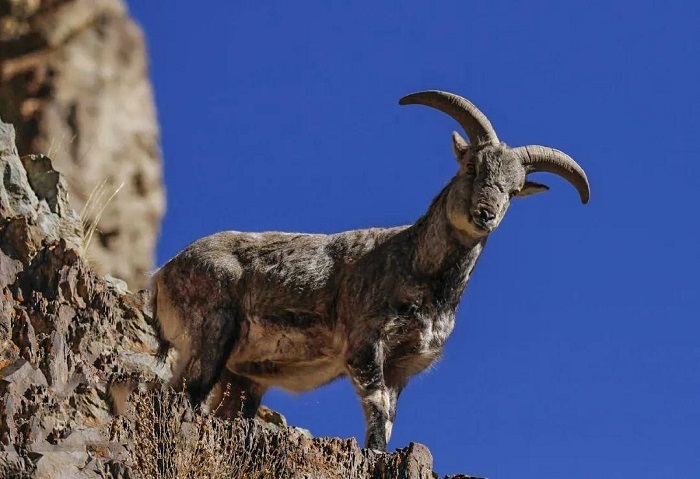
The Bharal is a species endemic to the Tibetan Plateau, living in forest-free mountains at an altitude of 2,500 to 5,000 meters. In summer, it forms a flock of ten to dozens, and in winter, it forms a large flock of hundreds, led by one or several male bharals. The bharals are mainly active at dusk. There are often one or two males standing on a high jutting-out rock and looking out. When their enemy begins to approach, they quickly rush to the bare rock area of high mountains. Because their fur color is very close to the rock, it is not easy to be found.
Tibetan Yak
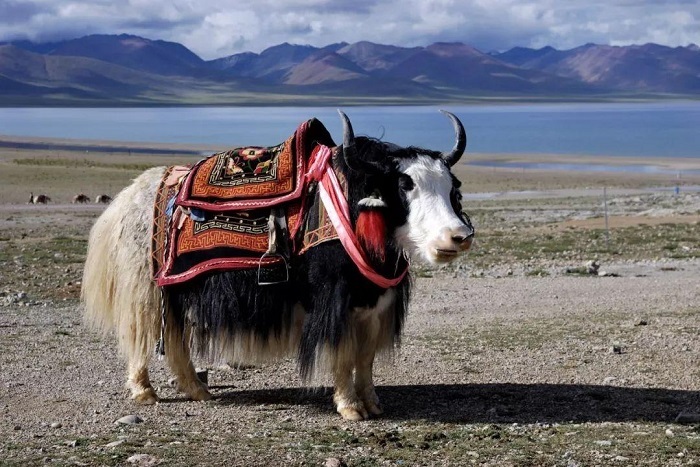
The Tibetan yak is transliterated as "Yaqui" in Tibetan. It's the most typical animal on the Tibetan Plateau, with a large body and strong vitality. The wild yak is the ancestor of the captive yak. It was once widely distributed but now only exists on the Tibetan Plateau. The weight can reach more than 1,000 kg, the body is dark brown, and the lower sides of the body and legs have dense long hairs, which is suitable for life in severely cold environments. The Tibetan yak is the main means of transportation in the vast pastoral areas and is also known as the "boat on the plateau". >> See more about Tibetan Yak
Tibetan Mastiff
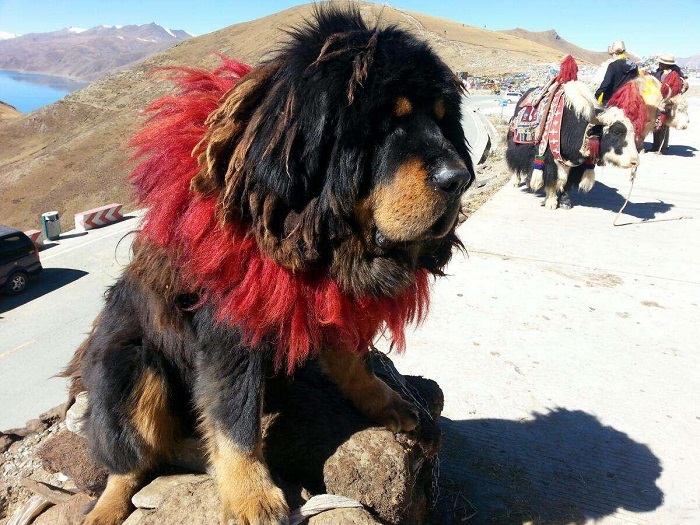
The Tibetan Mastiff is also known as the Mastiff Dog, native to the Tibetan Plateau in China. It's a tall, lop-eared, and ferocious dog. Tibetan Mastiff is about 120 cm long, with thick and rough body hair. Its character is resolute, strong, and fierce, and the wildness still exists, making people feel daunted. Tibetan Mastiff has strong hostility towards strangers and is good at attacking so it's been used to protect territory and food. In the Tibetan serf-owner society, only those kings and temple masters had the right to raise them, and Tibetan Mastiffs were regarded by Tibetans as sacred dogs, the mounts of living Buddhas. >> See more about Tibetan Mastiff
Snow Leopard
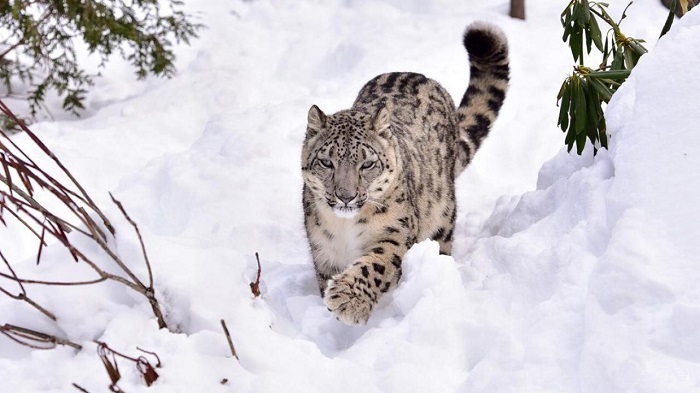
It is a rare animal unique to the Tibetan Plateau, beautiful and vigorous, with a gray and white coat. The body is covered with rosette-shaped brown spots, and the length is less than 4 feet. It looks very scary because of its thick soft hair and a thick and long tail. It is cautious by nature, secretive in action, and generally avoids crowds of people but does not take the initiative to attack people.
Tibetan Bear
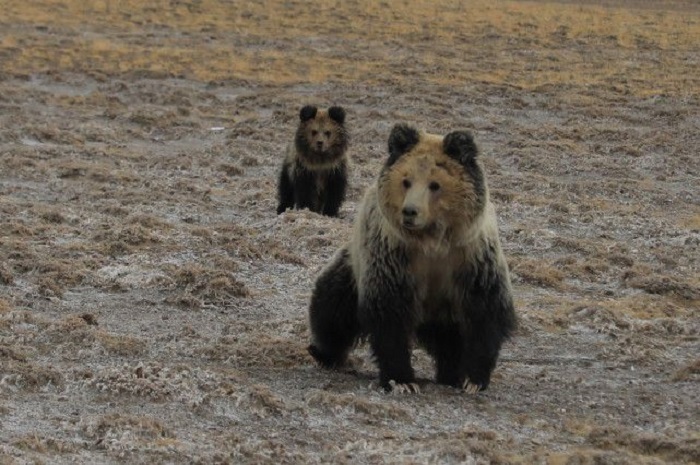
The Tibetan bear is one of the rarest brown bears in the world. The body is strong, and the character is fierce and powerful. It mainly inhabits the forest belt of the mountainous area and has a mixed diet.
Tibetan Wild Ass
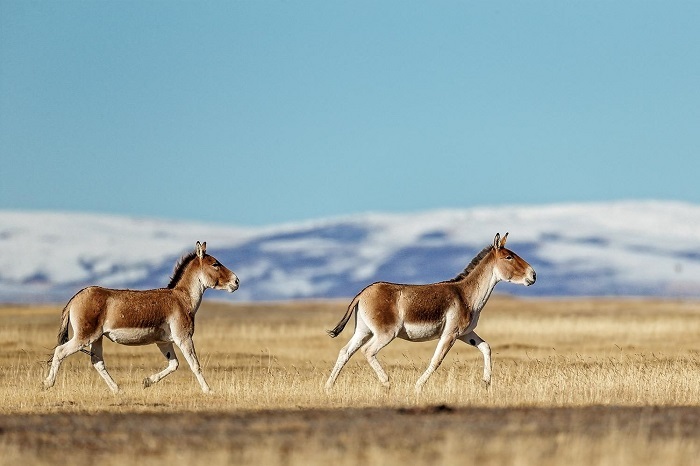
In Tibetan, it is called "Kiang". They like to live in groups, usually 8~20 donkeys. They are gray-brown all over, and their four legs are white as if they are wearing tall white socks. Tibetan wild donkeys are good at running. They are often seen racing against off-road jeeps. Their hooves are vigorous and strong, and their speed is equivalent to that of jeeps.
Black-necked Crane
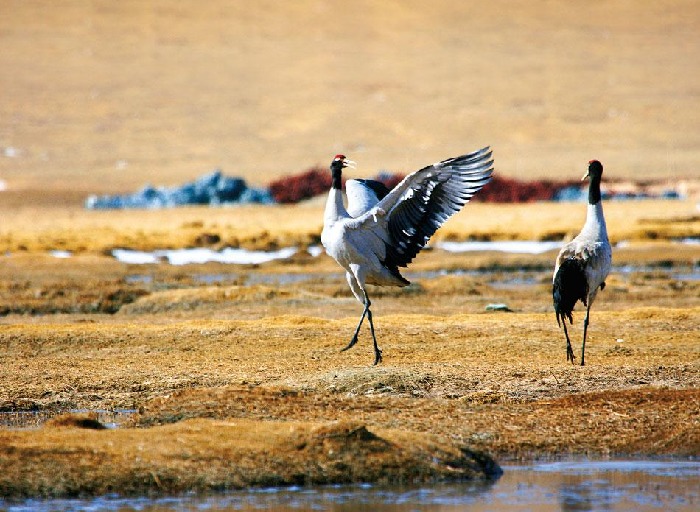
There are many species of cranes in the world, and the black-necked crane is one of the less well-known species, and it is also endemic to the Tibetan Plateau. Its legs and neck are very long, and its body is grayish-whit, only the neck is black and the top of the head is purple. Some people in Tibet call it "swan". Most of them live in swampy areas and flat banks of rivers and lakes on the plateau, singly or in small groups of 3-5. Black-necked cranes are tall, generally weighing more than 5 kilograms, and the larger ones can weigh 13-14 kilograms.
Marmot

Marmots, also known as "groundhogs", belong to the squirrel family along with squirrels, beavers, and chipmunks. Good at digging holes, usually its caves have more than two entrances for safety. Its most fascinating feature is its look, with lovely tail, short and chubby hands and feet. It has a pair of long front teeth in the front of its mouth, and its dull and silly look is quite flattering.
In addition, a list of animals of Tibet worth knowing:
| Rare Birds in Tibet | Great Black-headed Gull, Black-headed Gull, Blue Hill Pigeon, Tibetan Lark, Alpine Accentor, Tibetan Snowfinch, Asian House Martin, Carrion Crow, Oriental Turtle Dove, Collared Dove, Common Raven, Barn Swallow |
| Tibetan mammals | Tibetan Wolf, Tibetan fox, Palla’s cat, Red fox, Asian Badger, Goitered Gazelle, Przewalski’s Gazelle, White Lipped Deer, Tibetan Wild Ass, Blue Sheep, Black Lipped Pika, Snow Leopard, Tibetan Dwarf Hamster, Mountain Weasel, Bactrian Camel |
The Best Places to Watch Wild Animals in Tibet
In order to protect wildlife resources, the Tibet Autonomous Region government has successively approved the establishment of 11 nature reserves, of which five are national nature reserves.
Mount Everest Nature Reserve
Mount Everest Reserve is located at the junction of Tibet province and Himalaya highland. It covers an area of 33,810 square kilometers and is the most unique bio-geographic region in the world. In 2004, there were 53 species of mammals, 206 species of birds, 8 species of amphibians, 6 species of reptiles, and 10 species of fish.
Sanjiangyuan Nature Reserve
The Sanjiangyuan area is located in the southern part of Qinghai Province, with a total area ofmore than 316,000 square kilometers, accounting for 32.7% of the total land area of Qinghai Province.
The Sanjiangyuan Nature Reserve is the birthplace of the Yangtze River, the Yellow River, and the Lancang River. It's known as the "Chinese Water Tower". There are rich wild animal resources, with a variety of national first- and second-level protected animals. It is one of the concentrated areas of large, rare, and endangered wild animals that are rare in China and the world.
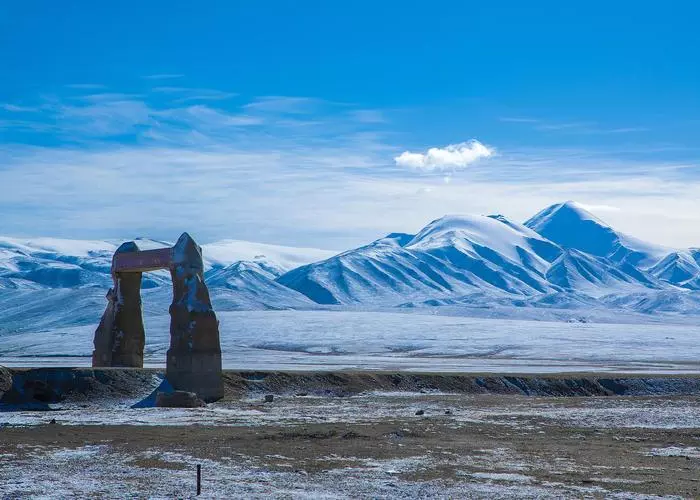
Qiangtang Nature Reserve
The Qiangtang Nature Reserve is located in the Nagqu and Ngari regions of the Tibet Autonomous Region. The vegetation types in the reserve are relatively simple, mainly alpine desert grasslands.
It is known that there are 38 species of vertebrates, 3 species of reptiles, 92 species of birds, and 13 species of fish. Among them, the wild animals listed as national key protection include more than 30 Tibetan wildlife species such as Tibetan antelope, wild yak, snow leopard, Tibetan wild donkey, argali, and black crane.
Hoh Xil Reserve
Hoh Xil is located to the west of Yushu Tibetan Autonomous Prefecture in Qinghai Province, with a total area of 4.5 million hectares. Although the natural environment here is harsh and humans cannot survive, the wild animals here live well as it's one of the regions with relatively complete ecological protection in the world. The environment here gives these plateau animals a unique survival advantage. Wild animals in Hoh Xil Reserve include rare animals and plants such as Tibetan antelopes, yaks, and Tibetan wild donkeys.
Yarlung Tsangpo River Reserve
The Yarlung Tsangpo Grand Canyon Nature Reserve is located in Motuo County, Tibet Autonomous Region, and is one of the areas with tropical biological types in Tibet. Rich in wild animal resources, it is known as the "natural zoo". Among them, there are more than 40 species of national key protected animals, mainly including the long-tailed monkey, leopard, horned pheasant, civet, python, Capricornis Sumatraensis, Muntiacus muntjak, Neofelis Nebulosa, lynx, gazelle, great hornbill, Pseudois Nayaur, Catopuma Temminckii, Tibetan snowcock, and Tibetan horse.
Conclusion
Tibet's unique wildlife, from the iconic Tibetan antelope to the elusive snow leopard, thrives in its vast and rugged landscapes. Protected by national reserves like Qiangtang and Hoh Xil, these rare species highlight the region’s rich biodiversity. For travelers, spotting these animals in their natural habitat is a breathtaking experience, underscoring the importance of continued conservation efforts to preserve Tibet’s remarkable ecosystem.
Email response within 0.5~24 hours.



